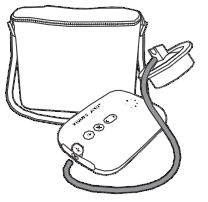Single Double Electric Breast Pump


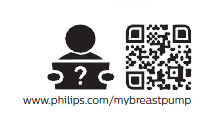
Single/Double electric breast pump SCF397, SCF395www.philips.com/mybreastpump
Foldout left only
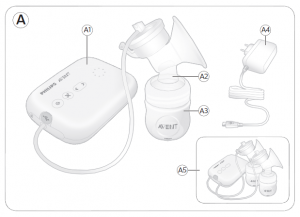
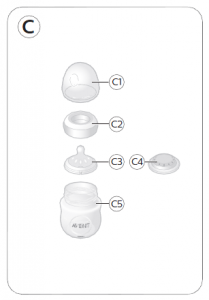

Introduction
Congratulations on your purchase and welcome to Philips Avent! To fully benefit from the support that Philips Avent offers, register your breast pump at www.philips.com/welcome.The Philips Avent single/double electric breast pump is inspired by babies and their natural suction movement. The soft silicone cushion stimulates the nipple with gentle massaging movements, helping you to express milk comfortably and effectively. The combination of suction and nipple stimulation triggers fast milk flow. The no-lean-forward design enables you to sit in a relaxed, upright position while expressing.
Healthcare professionals and the World Health Organization recommend breast milk as the primary source of nutrition during the first year of life, combined with solid food after the first 6 months. This is because your breast milk is specially adapted to your baby’s needs and helps to protect your baby against infection and allergies. To breastfeed longer, you can express and store your milk so that your baby can still enjoy the benefits of it, even if you cannot be there to provide it yourself. As the pump is compact, quiet and discrete to use, you can take it with you anywhere, allowing you to express milk at your own convenience and to maintain your milk supply.
If breastfeeding goes well, it is advisable (unless recommended otherwise by your healthcare professional) to wait until your milk supply and breastfeeding schedule are established (normally at least 2 to 4 weeks after giving birth) before you start expressing.
General description
Note: The numbers mentioned below refer to the numbers on the figure of the front foldout page of this user manual.Note: The double breast pump comes with two pieces of the items shown in Figures B and C.
Product description (Fig. A)
- A1 Motor unit
- A2 Breast pump kit
- A3 Bottle
- A4 Adapter
- A5 Double breast pump
Breast pump kit (Fig. B)
- B1 Silicone tube and cap
- B2 Silicone diaphragm
- B3 Pump body
- B4 Cover
- B5 Cushion
- B6 White valve
Philips Avent Natural Bottle (Fig. C)
- C1 Bottle cap
- C4 Sealing disc
- C2 Screw ring
- C5 Bottle
- C3 Teat
Accessories
There are multiple versions of this breast pump package, which all come with a different combination of the following Philips Avent accessories:
- Breast pads
- Breast milk storage bags*
- Travel bag
- Philips Avent Natural bottles
- Cleaning brush
- Thermo pads*
- Storage cups with adapter*
- Breast pump belt*
* For these accessories, a separate user manual is provided.
Intended use
The Philips Avent single/double electric breast pump is intended to express and collect milk from the breast of a lactating woman.The device is intended for a single user.
Important safety information
Read this user manual carefully before you use the breast pump and save it for future reference. This user manual can also be found online on the Philips Avent website: www.philips.com/avent.
Warnings
- Never use the breast pump while you are pregnant, as pumping can induce labor.
Warnings to avoid choking, strangulation and injury:
- This breast pump is not intended for use by persons (includingchildren) with reduced physical, sensory or mental capabilities, or lack of experience and knowledge. Such persons can only use this breast pump if they are supervised by or have received proper instruction concerning use of the appliance by a person responsible for their safety.
- Do not allow children or pets to play with the motor unit, the adapter, packaging materials or accessories.
- Always unplug the breast pump after use.
Warnings to prevent transmitting infectious diseases:
- If you are a mother who is infected with Hepatitis B, Hepatitis C or Human Immunodeficiency Virus (HIV), expressing breast milk will not reduce or remove the risk of transmitting the virus to your baby through your breast milk.
Warnings to avoid electric shock:
- Inspect the breast pump, including the adapter, for signs of damage before each use. Do not use the breast pump if the adapter or plug is damaged, if it does not work properly or if it has been dropped or submerged in water.
- Only use the adapter (S009AHz050yyyy) provided with this breast pump. – Always ensure that it is easy to disconnect the device from the mains in case of malfunction.
Warnings to avoid contamination and to ensure hygiene:
- For hygienic reasons, the breast pump is only intended for repeated use by a single user.
- Clean and disinfect all parts before first use and after each use.
- Do not use antibacterial or abrasive cleaning agents to clean the breast pump parts as this may cause damage.
- Wash your hands thoroughly with soap and water before you touch breast pump parts and breasts to prevent contamination. Avoid touching the inside of containers or lids.
Warnings to avoid breast and nipple problems including pain:
- Do not use the breast pump if the silicone diaphragm appears to be damaged or broken. See chapter `Ordering accessories’ for information on how to obtain replacement parts.
- Only use accessories and parts recommended by Philips Avent.
- No modification of the breast pump is allowed. If you do so, your warranty becomes invalid.
- Never use the breast pump while you are sleepy or drowsy to avoid lack of attention during use.
- Always switch off the breast pump before you remove the pump body from your breast, in order to release the vacuum.
- If the vacuum is uncomfortable or causes pain, switch off and remove the breast pump from your breast.
- Do not continue pumping for more than five minutes at a time if you do not succeed in expressing any milk. Try to express at another time during the day.
- If the process becomes very uncomfortable or painful, stop using the pump and consult your healthcare professional.
Warnings to prevent damage and malfunction of the breast pump:
- Portable radio frequency (RF) communications equipment (including mobile phones and peripherals such as antenna cables and external antennas) should not be used closer than 30 cm (12 in) to any part of the breast pump, including adapter. This could have negative effect on the performance of the breast pump.
- Use of this equipment adjacent to or stacked with other equipment should be avoided because it could result in improper operation.
Cautions
Cautions to prevent damage to and malfunctioning of the breast pump:
- Prevent the adapter and motor unit from coming into contact with water.
- Never put the motor unit or the adapter in water or in a dishwasher, as this causes permanent damage to these parts.
- Keep the adapter and the silicone tubes away from heated surfaces to avoid overheating and deformation of these parts.
Cleaning and disinfecting
Disassemble, clean and disinfect all parts that come into contact with breast milk before you use the breast pump for the first time and after every use.
Overview
Clean and disinfect the parts that come into contact with the breast and breast milk as described
Clean and disinfect the parts that come into contact with the breast and breast milk as described below:
When |
How |
|
|
|
Clean and disinfect before first use and after every use. |
Disassemble all parts and then clean them as described in chapter ‘Cleaning’ and disinfect them as described in chapter ‘Disinfecting’. |
When |
How |
|
|
|
Clean when needed. |
Wipe with a clean, damp cloth with water and mild detergent. |
Step 1: Disassembling
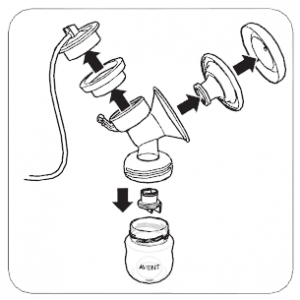
Make sure that you remove the white valve from the breast pump.
Step 2: Cleaning
The parts that come in contact with milk can be cleaned manually or in the dishwasher.
Warning: Do not use antibacterial or abrasive cleaning agents to clean the breast pump parts as this may cause damage.
Caution: Never put the motor unit or the adapter in water or in a dishwasher, as this causes permanent damage to these parts.
Caution: Be careful when you remove and clean the white valve. If it gets damaged, your breast pump does not function properly. To remove the white valve, gently pull at the ribbed tab on the side of the valve. To clean the white valve, rub it gently between your fingers in warm water with some dish-washing liquid. Do not insert objects into the white valve, as this may cause damage.
Step 2A: Manual cleaning
Supplies needed:
- Mild dish-washing liquid
- Drinking-quality water
- Soft, clean brush
- Clean tea towel or drying rack
- Clean sink or bowl
1. Rinse all parts under a running tap with lukewarm water.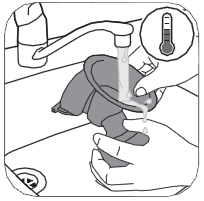 2. Soak all parts for 5 minutes in warm water with some mild dishwashing liquid.
2. Soak all parts for 5 minutes in warm water with some mild dishwashing liquid. 3. Clean all parts with a cleaning brush.
3. Clean all parts with a cleaning brush. 4. Thoroughly rinse all parts under a running tap with cold clear water.
4. Thoroughly rinse all parts under a running tap with cold clear water.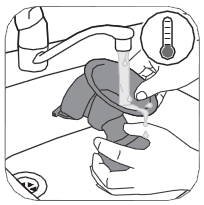 5. Leave all parts to air dry on a clean tea towel or drying rack.
5. Leave all parts to air dry on a clean tea towel or drying rack.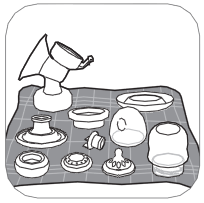
Step 2B: Cleaning in the dishwasher
Supplies needed:– Mild dishwashing liquid or a dishwashing tablet– Drinking-quality waterNote: Food coloring may discolor parts.
1. Place all parts on the top rack of the dishwasher.

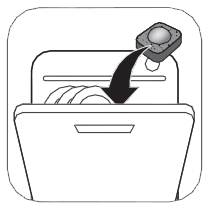





Step 3: Disinfecting
Supplies needed:– A household pot– Drinking-quality water
Caution: During disinfection with boiling water, prevent the bottle or other parts from touching the side of the pan. This can cause irreversible product deformation or damage that Philips cannot be held liable for.
1. Fill a household pot cover all parts and place all parts in the pot. Let the water boil for 5 minutes. Make sure the parts do not touch the side of the pot.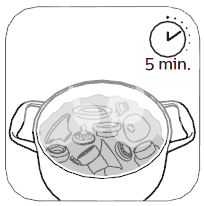









Using the breast pump
Cushion size
The Philips Avent single/double electric breast pump has a soft, active cushion. It gently stimulates your nipple to trigger milk flow. The cushion is made of flexible silicone, that adapts to up to 99.98 % of women, fitting nipple sizes up to 30 mm.
Assembling the breast pump
Make sure you have cleaned and disinfected the parts of the breast pump that come into contact with milk.
Warning: Be careful, when you have disinfected the breast pump parts by boiling them, they can be very hot. To prevent burns, only start assembling the breast pump when disinfected parts have cooled down.
Warning: Wash your hands thoroughly with soap and water before you touch breast pump parts and breasts to prevent contamination. Avoid touching the inside of containers or lids.Check the breast pump kit parts for wear or damage before use and replace them if necessary.
Note: Correct placement of the cushion, silicone diaphragm and silicone tube is essential for the breast pump to form a proper vacuum.
1. Wash your hands thoroughly with soap and water.




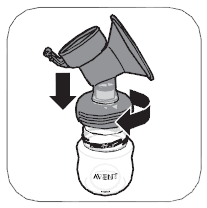

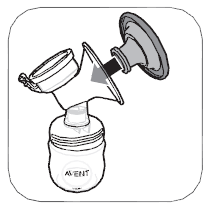

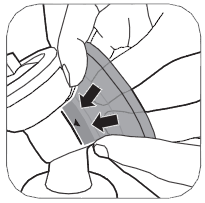

![]()
![]()
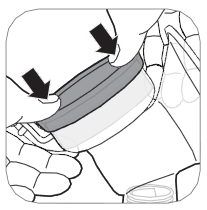

![]()
![]()


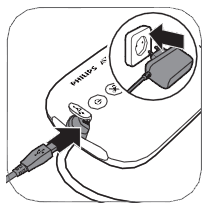

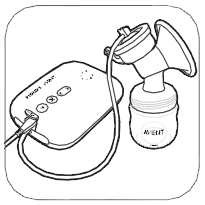

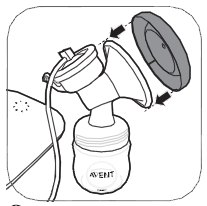

Motor unit part description


- USB power inlet
- On/off button with pause/play function
- Mode selection button
- ‘Level down’ button
- ‘Level up’ button
- Indicator lights for modes and levels
- Tubing port for single breast pump
- Tubing ports for double breast pump
Mode indicator lights
The breast pump has two modes. Below you find an explanation of these modes.
|
Indicator lights |
Mode |
Explanation |
No. of suction levels |
|
|
Stimulation mode |
Mode to stimulate the breast to start up the milk flow. |
8 suction levels |
|
|
Expression mode |
Mode for efficient milk removal after milk has started flowing. After 90 sec. of stimulation, the device automatically switches to the expression mode. |
16 suction levels |
Note: When you change the suction level, the display shows the selected suction level for a few seconds and then shows the selected mode again.
Suction level indicator lights
Suction level 1: Bottom light flashes
Suction level 2: Bottom light steady on
Suction level 3: Bottom light steady on + next light flashes
Suction level 4: 2 lights steady on.
Suction level 5: 2 lights steady on + next light flashes.
Suction level 16: all lights are on
Note: Every time the level increases, the next light starts flashing or the flashing light becomes solid.
Pumping instructions
Warning: Before you remove the pump body from your breast, always switch off the breast pump to release the vacuum.
Warning: Do not continue pumping for more than 5 minutes at a time if you do not succeed in expressing any milk. Try to express at another time during the day.
Warning: If the process becomes very uncomfortable or painful, stop using the pump and consult your healthcare professional.
Note: If you regularly express more than 125 ml/4 fl oz per session, you can purchase and use a 260 ml/9 fl oz Philips Avent Natural bottle to prevent overfilling and spillage.
1. Wash your hands thoroughly with soap and water and make sure that your breast is clean.


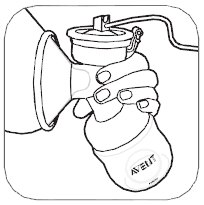

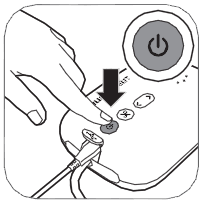

![]()
![]()




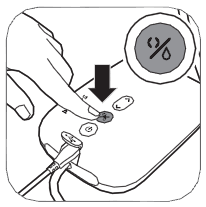



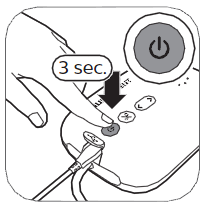

Tip: For optimal expression, choose the highest setting that still feels comfortable. This setting may differ across different sessions.Tip: You can use the double breast pump as a single breast pump by connecting only the tube of one pump kit to the motor unit.
After use
1. Unscrew the bottle.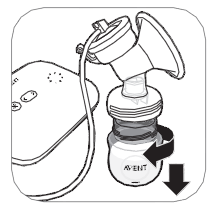

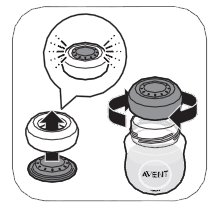

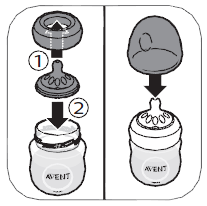

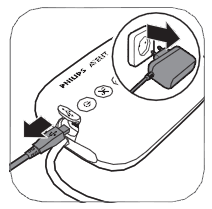

4. Remove the silicone tube and cap from the breast pump kit.
![]()
![]()
5. Disassemble and clean all parts that have been in contact with breast milk (see ‘Cleaning and disinfecting’).


6. For easy storage, wrap the silicone tube around the motor unit and clip the cap onto the tube.


Warning: Refrigerate or freeze expressed milk immediately or keep it at a temperature of 16-29 °C (60-85 °F) for a maximum of 4 hours before you feed your baby.For more information about the breast pump and tips for expressing milk, visit www.philips.com/avent.
Storing breast milk
Below you find guidelines for storing breast milk:
Storage location
Temperature
Room
16-29 C (60-85 F)
Refrigerator
4 C (39 F)
Freezer
< -4 C (25 F)
Max. storage duration 4 hours 4 days 6-12 months
Warning: Never refreeze thawed breast milk to avoid a decrease in milk quality.
Warning: Never add fresh breast milk to frozen breast milk to avoid a decrease in milk quality and unintended thawing of the frozen milk.
Feeding breast milk with the bottle
Warning: For your child’s safety and health
- Always use this bottle with adult supervision.
- Never use feeding teats as a soother, to prevent a choking hazard.
- Continuous and prolonged sucking of fluids will cause tooth decay.
- Always check the food temperature before you feed your baby.
- Keep all components not in use out of the reach of children.
- Keep the bottle cap away from children to avoid suffocation.
- Do not allow children to play with small parts or walk/run while using bottles.
- Inspect all parts before use and pull the feeding teat in all directions. Throw away any part at the first signs of damage or weakness.
- Always discard any breast milk that is left over at the end of a feed.
Caution: To avoid damage to the bottle
- Do not place in a heated oven, plastic can melt.
- Plastic material properties may be affected by disinfection and high temperatures. This can affect the fit of the bottle cap.
- Do not leave a feeding teat in direct sunlight or heat, or leave in disinfectant for longer thanrecommended because this may damage the product.
Before using the bottle
- Inspect the bottle and feeding teat before each use and pull the feeding teat in all directions to prevent a choking hazard. Throw away at the first signs of damage or weakness.
- Clean and disinfect the bottle before first use and after every use.
Assembling the bottle
- The teat is easier to assemble if you wriggle it upwards instead pulling it up in a straight line.

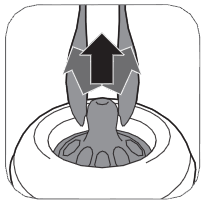
- Make sure you pull the teat through until its of lower part is aligned with the screw ring.

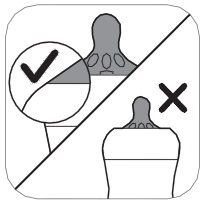
- Make sure you place the cap vertically onto the bottle so that the teat sits upright.

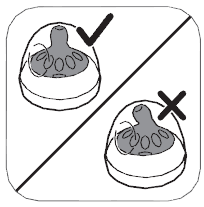
- Screw the screw ring with teat and cap on the bottle.

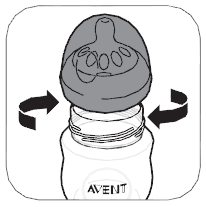
- To remove the cap, place your hand over the cap and your thumb in the dimple of the cap.

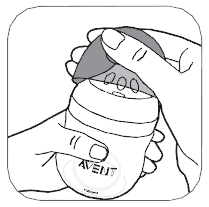
Heating breast milk
If you use frozen breast milk, let it defrost completely before you heat it.Note: If you need to feed your baby quickly, you can defrost the milk in a bowl of hot water.Heat the bottle with defrosted or refrigerated breast milk in a bowl of hot water or in a bottle warmer. Remove the screw ring and sealing disc from the bottle. Always stir or shake heated breast milk to ensure even heat distribution and test the temperature before serving.Warning: It is not recommended to use a microwave to warm up breast milk. Microwaves might alter the quality of breast milk and destroy some valuable nutrients and may produce localized high temperatures. If you heat up breast milk in the microwave, only place the container without screw ring, teat and cap in microwave. Always stir heated breast milk to ensure even heat distribution and check the temperature before serving.
English
English 19Choosing the right teat for your babyPhilips Avent teats are available with different flow rates. The breast pump comes with teat number 1. This is a 0m+ teat, ideal for newborn and breastfed babies of all ages. Use a lower flow rate if your baby chokes often, if milk dribbles out of its mouth during feeding or if it has trouble adjusting to the drinking speed. Use a higher flow rate if your baby falls asleep during feeding, gets frustrated or if feeding takes very long.Philips Avent teats are clearly numbered on the side, to indicate flow rate. For more information, see www.philips.com/avent.Storing the bottles– Store all parts in a dry, clean and covered container. – Do not leave a feeding teat in direct sunlight or heat, or leave in disinfectant (`sterilizing solution’)for longer than recommended, as this may weaken the parts. – For hygiene reasons, we recommend to replace the teats after 3 months.
CompatibilityThe Philips Avent single/double electric breast pump is compatible with all baby bottles in the Philips Avent Natural range and Philips Avent Storage cups with adapter. We do not recommend to use the Philips Avent Natural Glass bottles with the breast pump.
Ordering accessoriesTo buy accessories or spare parts, visit www.philips.com/parts-and-accessories or go to your Philips dealer. You can also contact the Philips Consumer Care Center in your country. When you order spare teats, make sure that you use a teat with the correct flow rate for your baby (see ‘Choosing the right teat for your baby’) and do not mix Philips Avent Anti-colic bottle parts and teats with parts of the Philips Avent Natural bottles. They do not fit and could cause leakage or other issues.
Recycling– This symbol means that this product shall not be disposed of with normal household waste (2012/19/EU).– Follow your country’s rules for the separate collection of electrical and electronic products. Correct disposal helps prevent negative consequences for the environment and human health.
20 EnglishWarranty and supportIf you need information or support, please visit www.philips.com/support or read the international warranty leaflet.
Troubleshooting
This chapter summarizes the most common problems you could encounter with the appliance. If you are unable to solve the problem with the information below, visit www.philips.com/support for a list of frequently asked questions or contact the Consumer Care Center in your country.
|
Problem |
Solution |
|
I experience pain when I use the breast pump. |
– Choose a suction level that is comfortable for you. – Check if the silicone diaphragm is undamaged (does not have small cracks, holes etc.). – Ensure that your nipple is placed in the center of the cushion. – If the pain persists, stop using the breast pump and consult your healthcare professional. |
|
The breast pump does not switch on (indicator lights do not go on). |
– Check if you are using the adapter that was supplied with the device and that the adapter is connected correctly to the motor unit and wall socket. – Connect the adapter to another wall socket and check if the breast pump can be switched on. – If the problem persists, contact the Consumer Care Center via www.philips.com/support. |
|
All indicator lights on the motor unit are flashing and device shuts off automatically. |
– Try to switch on the motor unit again. – Check if you are using the adapter that was supplied with the device. – If the problem persists, contact the Consumer Care Center via www.philips.com/support. |
|
I do not feel any suction/the suction level is too low. |
– If possible, try a higher suction level. – Check if the silicone diaphragm is assembled correctly (see ‘Assembling the breast pump’). – Check if the white valve is undamaged and assembled correctly (see ‘Assembling the breast pump’). – Check if the other parts of breast pump are intact and assembled correctly (see ‘Assembling the breast pump’). – Make sure that the pump is positioned correctly on the breast to allow a seal between breast pump and breast. – If you still do not feel any suction, please contact the Consumer Care Center via www.philips.com/support. |
English 21
|
Problem |
Solution |
|
The suction of the breast pump is too strong. |
– If possible, try a lower suction level. When you express for the first time, start with the default suction level (level 5 in stimulation mode, level 11 in expression mode) and increase/decrease the level when needed. During different expression sessions, different levels may feel most comfortable for you. – Make sure that you only use the Philips Avent breast pump parts provided with this breast pump. – Check if the silicone diaphragm is undamaged (does not have small cracks, holes etc.). – If the problem persists, contact the Consumer Care Center via www.philips.com/support. |
|
I express little/no milk when I use my Philips Avent breast pump. |
– If you do not feel enough suction, please check Troubleshooting item ‘I do not feel any suction/the suction level is too low’. – If you are using the Philips Avent breast pump for the first time, you may need to acquire some practice before you are able to express any milk. More expressing tips can be found on the Philips Avent website www.philips.com/avent. |
Supplemental information
Below some common breastfeeding-related conditions are described. If you experience any of these symptoms, contact a healthcare professional or breastfeeding specialist.
|
breastfeeding related condition |
Description |
|
Pain sensation |
Pain felt on the breast or nipple, or felt as a response to the suction being above a comfortable level. |
|
Sore nipples |
Persistent pain in the nipples at the beginning of the pumping session, or that lasts throughout the entire pumping session, or pain between sessions. |
|
Engorgement |
Swelling of the breast. The breast may feel hard, lumpy and tender. May include erythema (redness) of the breast area and fever. Usually occurs during the first days of lactation. |
|
Bruise, thrombus |
A reddish-purple discoloration that does not blanch when pressed. When a bruise fades, it may become green and brown. |
|
Injured tissue on nipple (nipple trauma) |
– Fissures or cracked nipples. – Skin tissue peeling off the nipple. Normally occurs in combination with cracked nipples and/or blisters. – Nipple tear. – Blister. Looks like small bubbles on the surface of the skin. – Bleeding. Cracked or torn nipples can lead to bleeding of the affected area. |
|
Clogged mammary ducts |
A red, tender lump on the breast. May include erythema (redness) of the breast area. Can lead to mastitis (breast inflammation) and fever if left untreated. |
Storage conditions
Keep the breast pump out of direct sunlight as prolonged exposure may cause discoloration. Store the breast pump and its accessories in a safe, clean and dry place. If the device has been stored in a hot or cold environment, place it in an environment with a temperature of 20 °C (68 °F) for 30 minutes to let it reach a temperature within the usage conditions (5 °C to 40 °C / 41 °F to 104 °F) before you use it.
Electromagnetic fields (EMF)
This Philips device complies with all applicable standards and regulations regarding exposure to electromagnetic fields.
Technical information
|
Single breast pump |
Double breast pump |
|
|
Vacuum level |
Stimulation: -60 to -200 mbar (-45 to -150 mmHg) Expression: -60 to -360 mbar (-45 to -270 mmHg) Adjustable in steps of 20 mbar Intermittent vacuum |
|
|
Cycle speed |
53-120 cycles/min. |
|
|
Motor unit rated input |
5 V d.c. / 1.1 A |
5 V d.c. / 1.8 A |
|
Mains adapter rated input |
External mains adapter 100-240 V a.c. / 50-60 Hz |
|
|
Adapter type number |
S009AHz050yyyy The letters “yyyy” represent the output current from 0100 (1000 mA) to 0180 (1800 mA), increments in steps of 100 mA. The letter “z” denotes type of plug, it can be: U, V, B, S, C, A, D, K, T, I, E, F. |
|
|
Mains adapter rated output |
5 V d.c. / 1.1 A |
5 V d.c. / 1.8 A |
|
Operating conditions |
Temperature 5 °C to 40 °C (41 °F to 104 °F) Relative humidity 15 to 90 % (non-condensing) |
|
|
Storage and transportation conditions |
Temperature -25 °C to 70 °C (-13 °F to 158 °F) Relative humidity up to 90 % (non-condensing) |
|
|
Operating pressure |
700 – 1060 hPa (<3000 m altitude) |
|
|
Net weight |
230 g |
310 g |
|
External dimensions |
Motor unit: 145 mm x 95 mm x 45 mm (LxWxH) |
|
|
Device classification |
IEC 60335-1: System: Class II; motor unit: Class III Construction |
|
|
Materials |
ABS, Silicone (motor unit) Polypropylene, Silicone (other parts) |
|
|
Service life |
500 hours |
|
|
Mode of operation |
Continuous operation |
|
Single breast pump |
Double breast pump |
|
|
Ingress protection |
IP22 (motor unit), IP20 (adapter) |
Explanation of symbolsThe warning signs and symbols are essential to ensure that you use this device safely and correctly and to protect you and others from injury. Below you find the meaning of the warning signs and symbols on the label and in the user manual. Symbol ExplanationIndicates to follow the instructions for use.
Indicates important information such as warnings and cautions. Indicates usage tips, additional information or a note.
Indicates the manufacturer. Manufactured for: Philips Consumer Lifestyle BV, Tussendiepen 4, 9206 AD Drachten The NetherlandsIndicates the manufacturing date.
Indicates that the part of the appliance that comes into physical contact with the user (also known as the applied part) is of type BF (Body Floating) according to IEC 60601-1. The applied part is the breast pump kit.Indicates ‘Class II Equipment’. The adapter is double-insulated (Class II).
Indicates manufacturer’s catalog number of the breast pump. Indicates the batch number of the breast pump. Indicates ‘direct current’. Indicates ‘alternating current’.
Indicates that the manufacturer has taken all necessary measures to ensure that the device complies with the applicable safety legislation for distribution within the European Community.Indicates separate collection for electrical and electronic equipment in accordance with the EU directive. Electrical waste products should not be disposed of with household waste. See chapter ‘Recycling’ for more information.
24 English
Symbol
ExplanationIndicates the protection against ingress of solid foreign objects and against harmful effects due to the ingress of water.Indicates the manufacturer’s serial number of the breast pump.
Indicates USB.
Indicates the relative humidity upper limits to which the device can be safely exposed: up to 90 %.Indicates the storage and transportation temperature limits to which the device can be safely exposed: -25 °C to 70 °C/-13 °F to 158 °F.Indicates Forest Stewardship Council. The FSC trademarks enable consumers to choose products that support forest conservation, offer social benefits, and enable the market to provide an incentive for better forest management. Indicates that an object is capable of being recycled – not that the object has been recycled or will be accepted in all recycling collection systems.Indicates that the packaging should be recycled and packaging fees have been paid to the green dot recycling organizations.Indicates that the breast pump meets the requirements of the EAEU technical regulations for electromagnetic compatibility.Indicates that the breast pump meets the requirements of the GOST R standards.
Indicates 2-year Philips worldwide guarantee.
Indicates that a specific adapter is required for connecting the breast pump.
References
[xyz-ips snippet=”download-snippet”]




